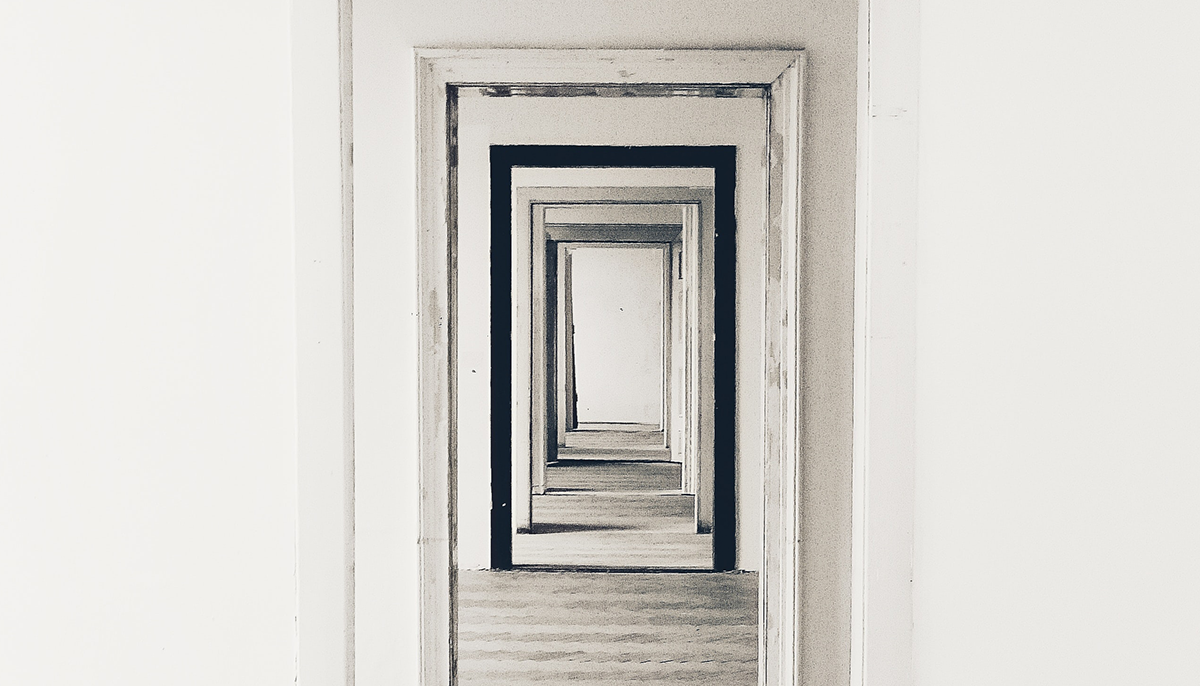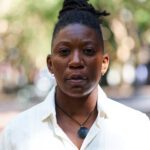Evolution
The foundations of self and a just society are in a state of overhaul and, although these changes are desired by many, there is considerable anxiety about the overhaul itself. Anxiety rests in a fear of repeating a history of change aligned in a biased, anti-Black (anti-Global Majority) manner. Anxiety also rests in the vulnerability of being in brave investigation of our values and their possible impacts. Working with anxiety, which is an impetus for change, requires a tolerance for slowing down and establishing a relationship with space.
Bardo experiences allow us to drop the work of maintaining an image.
Americans, in particular and ironically, have become intolerant of the gap between their request for change and the establishment of a new way of being. Historically, justice has been established in a binary, right-and-wrong manner; but this worn approach diminishes the gap where possibilities flourish—possibilities for a truly liberated society.
The gaps that exist at times of great transformation may be considered bardo states. Bardo is a Tibetan term meaning “intermediate state.” In this article we will explore the dismantling of constructs of how we arrive at just decisions. We will learn how to practice in the gap, using teachings and practices previously exclusive to individuals at the end of life. I write from the perspective of a first-generation, Queer, non-binary, Caribbean-American human whose visible markers meet that for a female body. I hold the privilege of being a doctor in a white-collar position; I am of lower-middle class, and I reside on coastal, unceded Native American Land. When I speak of Land, I am specifically referencing Turtle Island or North America.
The Delusion
In my early 30s I felt like I had made it – I felt in the best physical shape of my life, my career was blossoming, and I had had so much therapy and dharma practice I felt quite aware and grounded. I was doing most things right. I thought I knew my core, my habits, and my shortcomings and felt at ease with them. Even though I trashed my 27 year plan, I still felt I was hitting “the markers,” those unspoken yet normed by dominant culture rites of passage like owning a home with 2.5 kids and married to a person of the opposite sex. I had spent my youth “preparing” for most possible affiliations of the body and death and felt equipped. On a sunny day, after a long walk in the neighborhood I grew up in, I sat in my favorite chair, the one I often shared with my great-grandmother who was integral in raising me, and had a stroke.
We tend to find momentary comfort in creating the illusion of consistency. We all do it—from setting our schedule for the day, to planning travels, to the way we concretize our identities to introduce ourselves to others. This creates some predictability and can be efficient with the illusion that time can be saved, often to do “other things.” This cycle can constrict our choices, rather than opening us to limitless options.
In America, a way of being was enforced by those who colonized the Land that would help them to secure a position of dominance and control. These habits of constriction eventually led to what we now call white supremacy. Kenneth Jones and Tema Okun’s article White Supremacy Culture outlines these characteristics as: 1) fear 2) one right way 3) the binary 4) denial/defensiveness 5) right to comfort 6) individualistic 7) urgency 8) written word and 9) quantity over quality/ productivity wheel 1. When one engages in these characteristics, one is engaging in a way that views others as inferior to oneself. Using this as the undisputed model has led to a foundation that inherently opposes justice by leveraging the scales to favor select groups and a justice defined by conquest. How people should be treated, how one should be punished for wrong-doing, and how to restore relationships to “rightness” rests on the preservation of white supremacy as a singular narrative, a single path to justice. 2
This narrow, unwavering path devised ways for those in positions of power to view others as less-than, as property, and to relate to them through conquering and owning. I would add that being disembodied and forgetting are also key to maintaining this structure of violence. White supremacy is not held by white-bodied persons alone; it impacts all humans. I have seen its impact in myself through the influence of narratives in my own lineage. There were stories about the ways Caribbean people were never slaves, that American Blacks were still enslaved. Stories about having only one right way to be free on this Land—resisting being labeled as Black through perfectionism and academic and professional excellence—becoming the model minority. The irony is that in trying to sculpt an identity free of an enslaved way of being, I cosigned ways that made my actions aligned with the oppressor. As oppressor, I co-created an internal environment that was like cinder, coagulating to a clot, leading to my stroke.
The pandemics of 2020 raised anxiety in challenging the way things were, as the fragility of the majority culture’s ego and structural foundation shook. The Global Majority, through constant murders, inequities in access to care, and lack of justice were still holding the expectation of keeping this system well oiled and moving while dying at a disproportionate rate. The way we have been doing things clearly needed to change, but the ensuing trepidation about what would come next or the pressures to own dissociated harms left many either frozen and indifferent resignation, insistent on repeating former narratives, or fighting.
The Gap as the Ground
There was the stroke and then there was after the stroke. The latter was painful and filled with anticipation of another stroke (which eventually did transpire), denial, and trying to control every aspect of the experience initially. It was hard to stay awake in the beginning, like small deaths I knew would come but never knew if I would wake from. With no post-discharge plan and no explanation, every moment in-between waking and sleeping was potentially horrifying, but I was strangely calm on some level, especially when I could remember the teachings that talk about the importance of a gap, of these small bardos in living that help prepare one for the ultimate bardo, death. I was excited for the opportunity to practice.
Initially.
When I got home after the second stroke and subsequent hospitalization, the anxiety set into every gap. The bliss was gone. Was I dying? Losing faculties… forever? Why is there so much space between a thought and my body doing what it is told? Can I survive being THIS slow? Do others notice? Do I sound stupid? How can I be a doctor AND sound stupid? Who am I? Why does who I remember I am feel foggy? Am I still strong? Will my muscles atrophy ?Then the control sharply countered it – over 60% of strokes have an unknown cause, I don’t eat fried foods, I just need to sleep and it will heal the nervous system in X amount of time, I’ve heard magnesium deficiency could lead to strokes in younger folk so I need to get supplements. And then the anger, How can they discharge me without a plan? Why didn’t they test me further? How is just an aspirin supposed to prevent this from happening again? How did those doctors miss BOTH infarcts the first time? Is this discrimination?
There was a moment during the pandemic when things stopped long enough for people to care for one another and experience new ways of sharing resources. We were present to our lives in a unique way because there was little distraction from it. The collective experience of this liminal space was fertile for some and terrifying for others. The space the pandemic provided can be experienced as a bardo state. The bardo, often referring to the space after death and before the next life, can also fruitfully describe any break from what appears to be constant, any space without reference point and just before the next rebirth or iteration of an experience.
In the bardo of the pandemic, people tended to polarize into two camps: those who saw this space as an opportunity to reconstruct systems and ways that were causing dis-ease that often stripped humanity and those who were paralyzed by fear and held tightly to the desire to return to things as they were. Then there is the gap, the space I found myself in repeatedly during the stroke and recovering. As each moment was slowed, there was both a whole lot of nothing but also a whole lot of everything—possibility. Who might I be in this next iteration, this next lifetime? What would they do?. What is right? Do we ask infants to get it right? How can I honor parts of me that are in infancy now? What does it look like to rest? What did I notice at this moment? Who are my guides? What do they look like? Imagine them and rest. Rest is integration. What do I notice now? Who am I trying to remember? How does remembering that person serve this moment? Do you remember the Heart Sutra? Try to recite it. Do you remember the melody of that prayer? The questions were ongoing, none had answers but there was a playfulness in the exploration. In each arising there was a sense of peace even though there were no answers. I was able to hold this curiosity and not fear the vulnerability of forgetting because of the view that the gap was intrinsically good. In the bardo of the pandemic, there too is the opportunity to lean into the juicy middle of opportunity.
Bardo experiences allow us to drop the work of maintaining an image. In being present to the space, to the gap, we come into awareness that there is nothing to hold onto and that every possibility is available to us. This space of emptiness is called shunyata. Emptiness usually brings to mind nothingness; but here emptiness is the simultaneity of loss and of endless possibility. Nothingness is the potential for everything.
The gap is where we can explore justice and engage change. Here we learn that possibility is not what we feared. Perhaps, when we are less afraid of losing ourselves, we might engage others. In engaging others we could become curious about their stories. In hearing other narratives, without reactivity, we could experience interconnection—knowing our existences are intertwined. In acknowledging this interconnectedness we could be open to caring for others and nurturing relationships. If we choose to hold the view of bardo as beneficial, then these gaps or pauses in “the way” can be vibrant catalysts toward liberatory change. As we continue our journey, we will discuss how to create your own bardo practice that can be used in everyday life.
This article was created in collaboration with Buddhist Justice Reporter (BJR), founded by BIPOC Buddhist practitioners in response to the police torture and murder of George Floyd. BJR publishes articles on issues related to environmental, racial, and social justice and its intersections, from an anti-racist Buddhist lens.

